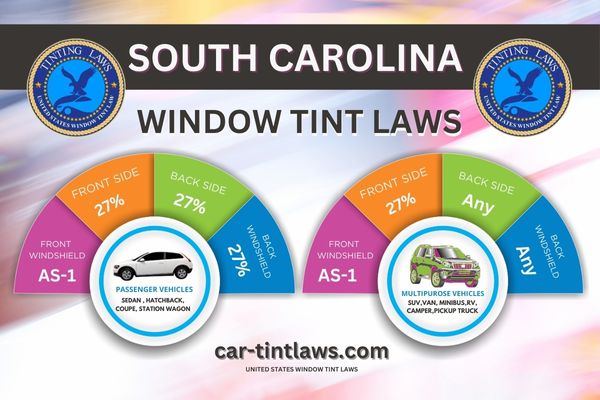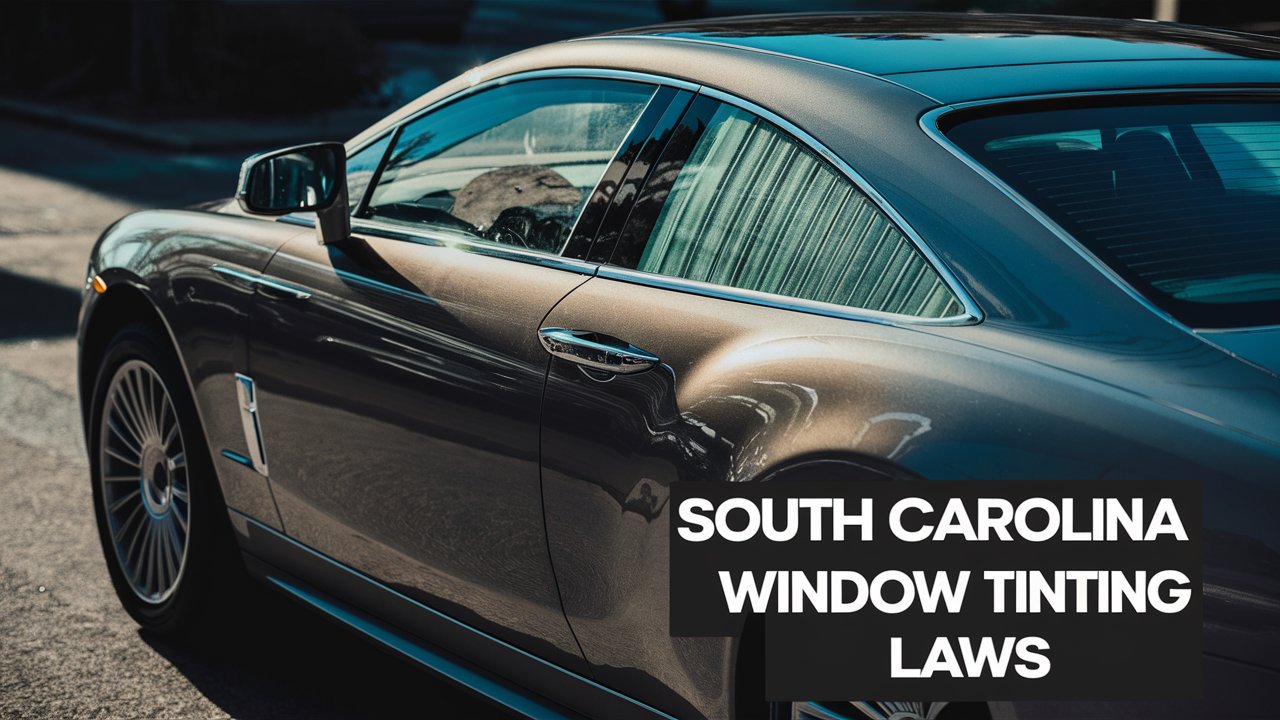Have you ever wondered if the theory that South Carolina’s window tinting laws are among the strictest in the country holds any water?
When it comes to tint darkness and reflection limits, the state does have some detailed regulations that you need to be aware of, especially if you’re driving a sedan or an SUV.
For instance, did you know that sedans can’t have reflective tints and must allow more than 27% light transmission through all windows, except the top 6 inches of the windshield?
Understanding these specifics could save you from fines starting at $200 and make sure you’re driving safely.
Window Tint Darkness in South Carolina
When discussing tint darkness for sedans in South Carolina, you’ll need to make sure that your front side windows allow more than 27% of light to pass through, while reflective tint is prohibited.
For SUVs and vans, the rules are slightly different; you can have any level of darkness on the rear windows, but the front side windows must still allow more than 27% light transmission and should be non-reflective.
These regulations are important for maintaining visibility and safety on the road.
Tint darkness for sedans:
In South Carolina, sedan owners must comply with specific tint darkness regulations for their windows.
Here are the guidelines to follow:
- Windshield: Non-reflective tint is allowed on the top 6 inches of the windshield.
- Front Side windows: Must allow more than 27% of light in.
- Back Side windows: Must allow more than 27% of light in.
- Rear Window: Must allow more than 27% of light in.
It’s important to note that only non-reflective tint is permitted on the front and back side windows of sedans in South Carolina.
Reflective tints are not allowed as they can impede visibility and lead to issues with law enforcement.
Ensuring your sedan’s windows meet these requirements not only keeps you compliant with the law but also contributes to road safety for yourself and others.
Law enforcement officers are diligent in enforcing these regulations, so adherence is crucial.
Tint darkness for SUV and Vans:
- Windshield: Tinting above the AS-1 line is permitted.
- Front Side windows: Must allow more than 27% of light in.
- Back Side windows: Must allow more than 27% of light in.
- Rear window: Any darkness of tint can be applied
Window Tint Reflection in South Carolina
When you’re considering window tinting for sedans, SUVs, or vans in South Carolina, it’s important to remember that reflective tints are not permitted on any windows.
The state mandates that both front and back side windows must be non-reflective, ensuring that your vehicle complies with local regulations.
This means you’ll need to choose tints that meet these non-reflective criteria to avoid any legal issues.
Tint reflection for sedans:
- Front Side windows: Reflective tint is prohibited.
- Back Side windows: Reflective tint is prohibited.
Tint reflection for SUV and vans:
- Front Side windows: Must have non-glaring tint and must not be reflective.
- Back Side windows: Must have non-glaring tint and must not be reflective.
Other South Carolina window tint rules and regulations
- Side Mirrors: No restrictions.
- Restricted Colors: In South Carolina, all tint colors are permitted.
- Certificates: Manufacturers of film need to certify the film they sell in the state. Ask your dealer if they are using certified film.
- Stickers: The sticker/label of compliance to identify legal tinting is required between the film & glass on each tinted window.
- Medical Exceptions: South Carolina permits medical exemptions for special tint. For more details about the specific terms of the exemption, consult SC state law.
- Penalties: Violating tint regulations in South Carolina can result in fines. Ticket costs vary depending on the specific infraction, so it’s important to ensure compliance to avoid penalties and maintain safety on the road.

Medical Exemptions for Window Tint Rules in South Carolina
Having a medical condition that requires special tint levels means you can apply for a medical exemption under South Carolina’s window tinting laws.
Medical exemptions allow you to exceed standard limits set by the state, provided you have the proper documentation.
This documentation must come from a healthcare provider, proving the medical necessity for darker tint levels.
Applications for these exemptions are evaluated on a case-by-case basis, making sure that only those with legitimate medical needs receive approval.
Once you have the exemption, it’s important to remember that you still need to comply with other window tint regulations in South Carolina.
For instance, reflective tints and certain prohibited tint colors are not allowed, regardless of your medical exemption status.
If you believe you qualify, start by consulting your healthcare provider for the necessary documentation.
This step is essential, as incomplete or incorrect paperwork can delay or deny your exemption request.
Once you have the documentation, submit it to the appropriate authorities for review.
By following these steps, you can guarantee that your vehicle meets both your medical needs and South Carolina’s legal requirements.
South Carolina Window Tint Ticket Cost
Violating South Carolina’s window tint laws can hit your wallet hard, with ticket costs starting at a minimum of $200.
When it comes to window tint violations, the fines can quickly add up and become quite expensive.
Not only do you risk paying hefty fines, but in extreme cases, you could face up to 30 days in jail.
This makes it essential to understand and comply with the state’s regulations.
South Carolina requires stickers on all tinted windows to identify legal tint levels.
These stickers must be placed between the film and the glass on each tinted window.
Failure to have these stickers can result in additional violations and fines. It’s important to verify that your vehicle’s tint complies with the legal requirements to avoid unnecessary penalties.
Violations of South Carolina’s window tint laws are considered misdemeanors.
This means that if you’re caught with illegal tint, it will go on your record as a criminal offense.
Understanding these regulations and adhering to them can help you avoid the financial and legal repercussions associated with non-compliance.
By staying informed and following the rules, you’ll avoid the steep window tint ticket costs and other penalties in South Carolina.
South Carolina Legal Overview
In South Carolina, window tinting laws specify the allowed darkness and reflection for vehicle windows, ensuring compliance with safety standards.
For sedans, your front side windows, back side windows, and rear window must allow more than 27% light in, while SUVs and vans have specific regulations for each window type.
Reflective tints are prohibited on both front and back side windows for all vehicles, and violating these laws can result in hefty fines and possible jail time.
Tint Darkness Regulations
When discussing tint darkness regulations in South Carolina, it’s vital that your vehicle’s windows permit more than 27% of light to pass through to remain within legal limits.
The law dictates that both front and back side windows, along with rear windows, must adhere to this standard.
This rule is based on the Visible Light Transmission (VLT) percentage, which assesses the light passing through the window film.
The tint darkness should not diminish the light transmission below this level.
For side windows, the law is explicit: they must sustain a visible light transmission of over 27%.
This guarantees that your vehicle meets safety standards and avoids any legal complications.
Selecting a window film that meets these criteria is necessary to prevent fines and other repercussions.
Moreover, the windshield must have non-reflective tint above the AS-1 line to maintain visibility.
Adhering to these tint darkness regulations is essential for the safety of all road users.
By adhering to these guidelines, you will not only comply with South Carolina’s regulations but also contribute to a safer driving environment for everyone.
Tint Reflection Limits
South Carolina’s tint reflection limits mandate that both front and back side windows have non-reflective tint to guarantee safe driving conditions.
This requirement is in place to make sure that your South Carolina Window not only looks good but also complies with the law.
By keeping the tint non-reflective, visibility is maintained, reducing glare and making it easier for both drivers and pedestrians to see clearly.
You might wonder why this is so important. Law enforcement officers are keen on making sure that everyone follows these tint reflection limits.
They do this to make certain that visibility is not compromised, which could contribute to safer driving conditions on the road.
The rules for front side windows and back side windows are the same, meaning that all side windows on your vehicle should have non-reflective tint.
Adhering to these regulations helps you avoid any legal issues, including fines and penalties, ensuring you stay on the right side of the law.
Understanding and following the tint reflection limits is essential for everyone driving in South Carolina, as it helps maintain a safe and legal driving environment.
Vehicle-Specific Rules
As you navigate South Carolina’s window tinting laws, it’s important to understand the specific regulations for different types of vehicles.
For sedans, the law mandates that front side windows must allow more than 27% light in, and the same applies to back side windows and rear windows.
Reflective tint isn’t permitted on any of these windows, making sure that they don’t reflect incoming light excessively.
When it comes to SUVs and vans, the regulations are a bit different.
The front side windows still need to allow more than 27% light in, but for the back side windows, you can apply any darkness a few inches from the top.
Additionally, the rear windows on SUVs and vans can be as dark as you like. However, just like sedans, reflective tint isn’t allowed on any of the windows.
Windshields present another set of specific regulations.
For all vehicles, including sedans, SUVs, and vans, any tint applied must be non-reflective and positioned above the AS-1 line.
These rules make certain that your vehicle’s window tint meets the Palmetto State’s darkness requirements and doesn’t pose a safety hazard by reflecting incoming light.
References
South Carolina Code of Laws section 56-5-5015: Sunscreen devices. (scroll to section 56-5-5015)
Frequently Asked Questions
What’s the Darkest Legal Tint in South Carolina?
You’re wondering about the darkest legal tint percentage for car windows. In South Carolina, the legal limit for front side windows is 27% VLT.
This guarantees vehicle visibility, offers UV protection and heat reduction, and aids police enforcement.
How Much Is a Tint Ticket in South Carolina?
You might face a fine amount starting at $200 for a tint ticket. If your tint percentage exceeds legal limits, the penalty cost could skyrocket.
Police enforcement may even require tint removal, unless you have a tint waiver.
How Do I Get a Tint Exemption in Sc?
To get a tint exemption, start the exemption process by obtaining documentation required from a medical professional stating medical reasons.
You’ll need approval, vehicle inspection, and to display the tint percentage. Approval timeframe varies; tint removal may be necessary.
What Is the Darkest Tint Legal in a Car?
The darkest shade allowed for car windows is 27% VLT. South Carolina’s tint laws guarantee car safety and window visibility.
Adherence to these restrictions is essential, and the tint exemption process exists for those needing special consideration.
Conclusion
Understanding South Carolina’s window tinting laws is important for compliance and safe driving.
For sedans, make sure non-reflective tint on the top 6 inches of the windshield and over 27% light transmission on other windows.
Reflective tints are a no-go for sedans. SUVs have varied regulations for front and rear windows.
Fines start at $200 for violations, so staying informed is key.
This knowledge helps you avoid penalties and guarantees you meet safety standards.
